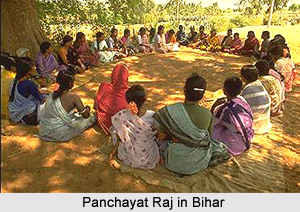 Local Self Governments of Bihar played a major role in maintaining peace and harmony in social arena of Bihar. The village has been the lowest unit of administration in the history. The British administrators had to deal with the remnants of the former system. Late Dr. Sachchidanand Sinha was the first President of the newly elected Constituent Assembly which was utilized as the foundation of the new system. Lord Ripon is regarded as the founder of the present system Local administration. Since 1870 continuous efforts were made to create a village council to collect the pay of the village watchman. Old village machinery was utilized for the extension of Primary education. In 1813 and 1819 money was raised in Bengal by Regulations which decreed that Public Ferries should be controlled and managed by the Government for the safety and convenience of travellers. The surplus proceed was used for repairing and construction of roads, bridges and drains. Local committees were appointed, with District Magistrate as Secretary, to advise the Government of the need of such district and to see that the money allotted was properly spent. These committees had no legal power to raise funds and their work was in strict subordination to the Local Government.
Local Self Governments of Bihar played a major role in maintaining peace and harmony in social arena of Bihar. The village has been the lowest unit of administration in the history. The British administrators had to deal with the remnants of the former system. Late Dr. Sachchidanand Sinha was the first President of the newly elected Constituent Assembly which was utilized as the foundation of the new system. Lord Ripon is regarded as the founder of the present system Local administration. Since 1870 continuous efforts were made to create a village council to collect the pay of the village watchman. Old village machinery was utilized for the extension of Primary education. In 1813 and 1819 money was raised in Bengal by Regulations which decreed that Public Ferries should be controlled and managed by the Government for the safety and convenience of travellers. The surplus proceed was used for repairing and construction of roads, bridges and drains. Local committees were appointed, with District Magistrate as Secretary, to advise the Government of the need of such district and to see that the money allotted was properly spent. These committees had no legal power to raise funds and their work was in strict subordination to the Local Government.
In 1882 a step was taken towards the application of these principles of Local Government and the Sub-division was chosen to be the smallest administrative unit to be placed under the Local Board. The District was placed under a District Board. Besides that Municipalities and Union Boards were established. The main works entrusted to the Local Bodies were: (a) Education, (b) Sanitation, (c) Communications, and (d) arrangements of lights on the streets etc. The coming of the national leaders into power brought revolutionary changes in our local administration. They have given more powers to the local bodies. The State Government has passed the Bihar Panchayat Act. According to this Act minor cases will be dealt with by a popularly elected body in the village. It will bring about harmonious relationship among the villagers and foster a sense of responsibility. The Panchayat is working in a large part of the State.
This article is a stub. You can enrich by adding more information to it. Send your Write Up to content@indianetzone.com



















